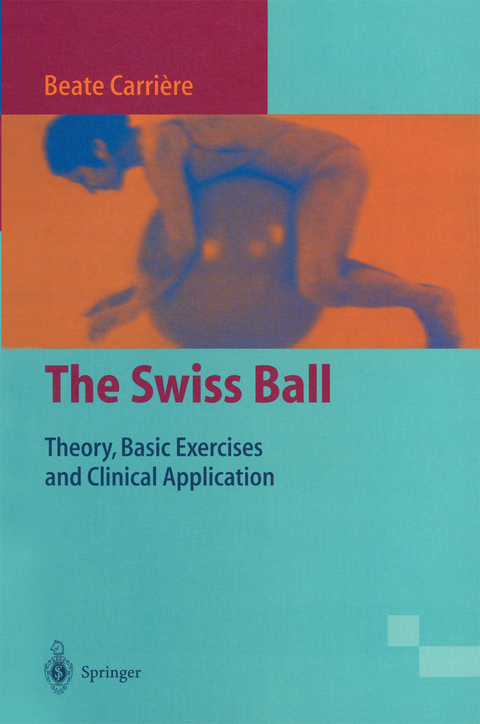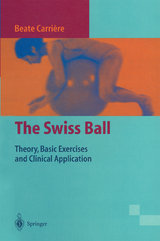The Swiss Ball
Springer Berlin (Verlag)
978-3-540-61144-8 (ISBN)
I have known Beate Carriere for several years and have always been impressed by her deep understanding of the whole field of physiotherapy. In our discussions her questions and comments have been inspiring and demonstrate that her knowledge is not only based on reading but rather on life-long clinical practice and experience. Thus, it is no wonder that her book is excep tional, presenting the physiology, the pathophysiology, and a technical description of recommended exercises and their clinical application - and not as general recommendations but with con vincing examples. All three of the sections are written in clear, understandable language. The author discusses the use of the Swiss ball; however, she did not limit herself to a technical description. Instead she set out to discover the underlying physiological mechanisms and has succeeded in showing how a knowledgable physiotherapist can contribute to the development of physiotherapy as a science. Though based on the concept of S. Klein-Vogelbach, Beate Carriere has added so many of her own exercises, descriptions, and explanations that we are justified in speaking about the Carriere concept of using the Swiss ball. What I appreciate in particular is her critical view and attempt to see the patient and his problems from all possible aspects. Therefore, she does not consider the Swiss ball program the one and only means of treat ment but incorporates other approaches as well.
1 History of the Swiss Ball.- 1.1 Introduction.- 1.2 History of Literature on the Swiss Ball.- References.- 2 Neuroanatomical, Neurophysiological, and Physiological Bases: A Hypothesis.- 2.1 Brain Stem and Reticular Formation.- 2.2 Cerebellum.- 2.3 Vestibular System.- 2.4 Hypothalamus.- 2.5 Thalamus.- 2.6 Basal Ganglia.- 2.7 Autonomic Nervous System.- 2.8 Limbic System.- 2.9 Sensorimotor System.- 2.10 Physiological Responses.- References.- 3 Motor Learning.- 3.1 Stages of Learning.- 3.2 Knowledge of Result, Knowledge of Performance.- 3.3 Feedback.- 3.4 Clinical Applications: Examples.- 3.5 Plasticity of the Brain.- References.- 4 Practical Considerations.- 4.1 Ball Conditions.- 4.2 Safety Conditions.- 4.3 Precautions, Contraindications.- References.- 5 Points of Observation.- 5.1 Ball-Floor.- 5.2 Ball-Body.- 5.3 Body-Floor.- 5.4 Base of Support.- 5.5 Bisecting Plane.- 5.6 Body Distances.- 5.7 Hinged Joints.- 5.8 Continuing Movement and Buttressing.- References.- 6 Exercise Terminologyand Muscle Activity.- 6.1 Exercise Terminology.- 6.2 Variations of Muscle Activity.- 6.3 Primary Movement, Actio-Reactio.- 6.4 Conditio-Limitatio.- References.- 7 Planning of Exercises, Screening, Evaluation, and Treatment.- 7.1 Evaluation.- 7.2 Muscle Strength and Range of Motion.- 7.3 Back Extensor and Trapezius Muscles: Testing Strength.- 7.4 Triceps Brachii Muscle: Testing Strength.- 7.5 Abdominal Muscles and Hip Flexor Muscles (Iliopsoas): Testing Strength in Sitting Position.- 7.6 Evaluating Alignment.- 7.7 Evaluating Quality of Movement and Dissociation of the Lower Extremities.- 7.8 Testing Balance.- 7.9 Identifying Neurotension Problems and Treatment.- References.- 8 Assistive Devices.- 8.1 Sitfit and Swiss Ball.- 8.2 Foam Roll and Swiss Ball.- 8.3 Swiss Ball and Thera-Band.- 8.4 Swiss Ball and Dumbbells.- 8.5 Swiss Ball as an Assistive Device in Manual Therapy.- References.- 9 Exercise Descriptions.- 9.1 "Cowboy".- 9.2 "Scale".- 9.3 "Indian Fakir".- 9.4 "Donkey Stretch Yourself".- 9.5 "Stretch Myself".- 9.6 "Sea Gull".- 9.7 "Hula-Hula, Forward/Backward".- 9.8 "Hula-Hula, Side to Side".- 9.9 "Salamander".- 9.10 "Swing".- 9.11 "Duck".- 9.12 "Crab".- 9.13 "Trot".- 9.14 "Sea Urchin".- 9.15 "Goldfish".- 9.16 "Walking on Hands".- 9.17 "Push Me-Pull Me".- 9.18 "Figurehead".- 9.19 "Scissors".- 9.20 "Mermaid".- 9.21 "Carrousel".- 9.22 "Perpetual Motion".- 9.23 "Pendulum".- 9.24 "Rock'n Roll".- 9.25 "Move My Leg".- 9.26 "Easter Bunny".- 9.27 "Well Figure".- 9.28 "Cocktail Party".- 9.29 "Dolphin".- 9.30 Summary of Exercises.- References.- 10 Intensive and Acute Care.- 10.1 Introduction.- 10.2 Applications.- 10.3 Selection of Patients.- References.- 11 Orthopedic and Sports Medicine.- 11.1 Introduction.- 11.2 After ACL Reconstruction.- 11.3 After Shoulder Injuries and Surgeries.- 11.4 Posture.- 11.5 Dysfunctions of the Back.- 11.6 Scoliosis.- References.- 12 Medical/Surgical Outpatient Care.- 12.1 Surgical Patients.- 12.2 Medical Patients.- 12.3 Osteoporosis.- 12.4 Ankylosing Spondylitis.- References.- 13 Neurological Outpatient Care.- 13.1 Introduction.- 13.2 Symptoms.- 13.3 Restoration of Function.- 13.4 Physical Therapy in Neurological Deficits.- 13.5 Physical Therapy in Parkinson's Disease.- 13.6 Physical Therapy After Cerebral Vascular Accidents.- 13.7 Physical Therapy in Multiple Sclerosis.- 13.8 Physical Therapy in Muscular Dystrophy.- 13.9 Physical Therapy in Cerebral Palsy.- References.- 14 Incontinence.- 14.1 Introduction.- 14.2 Tanzberger Concept for Functional Exercises of the Pelvic Floor.- 14.3 Anatomy of the Pelvic Floor.- 14.4 The Pelvic Floor and its Functional Connections.- 14.5 Medical Conditions Which May Require Pelvic Floor Exercises.- 14.6 Retraining the Pelvic Floor Muscles.- 14.7 Description of Swiss Ball Exercises.- 14.8 Exercise Examples.- References.- 15 Preventive Applications.- 15.1 Introduction.- 15.2 Evaluating Postural Alignment in Healthy Persons.- 15.3 Applications to Prevent Injury of the Musculoskeletal System.-15.4 Treatment Examples.- References.
| Erscheint lt. Verlag | 25.11.1997 |
|---|---|
| Co-Autor | R. Tanzberger |
| Vorwort | V. Janda |
| Zusatzinfo | XXIV, 385 p. 561 illus. |
| Verlagsort | Berlin |
| Sprache | englisch |
| Maße | 155 x 235 mm |
| Gewicht | 600 g |
| Themenwelt | Geisteswissenschaften ► Psychologie ► Klinische Psychologie |
| Medizin / Pharmazie ► Gesundheitsfachberufe | |
| Medizin / Pharmazie ► Medizinische Fachgebiete ► Psychiatrie / Psychotherapie | |
| Medizin / Pharmazie ► Physiotherapie / Ergotherapie ► Rehabilitation | |
| Schlagworte | Bewegungstraining • clinical application • functional kinetics • Gymnastikball • Gynäkologie • gynecology • nervous system • Neurologie • Neurology • Orthopädie • Orthopedics • Parkinson • physical therapy • Physiotherapie • sports medicine |
| ISBN-10 | 3-540-61144-4 / 3540611444 |
| ISBN-13 | 978-3-540-61144-8 / 9783540611448 |
| Zustand | Neuware |
| Haben Sie eine Frage zum Produkt? |
aus dem Bereich




